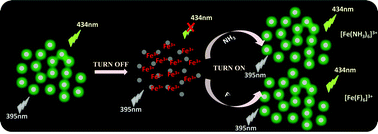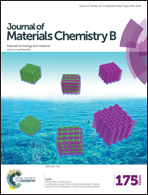Carbon nanoparticles for ferric ion detection and novel HFCNs–Fe3+ composite for NH3 and F− estimation based on a “TURN ON” mechanism†
Abstract
In this study we have synthesised and characterised hollow fluorescent carbon nanoparticle (HFCNs) and solid fluorescent carbon nanoparticle (SFCNs) separately using Syzygium cumini extract via a self-catalysis method in large scale for commercialization without providing any external heat. The characterisation of both HFCNs and SFCNs was performed by employing various techniques like UV-Vis, PL, IR, Raman, XPS, TCSPC, FESEM and TEM. The hollow interior of the HFCNs was corroborated by the TEM images. The average particle size distribution of the HFCNs was ∼20–40 nm and their pore size was ∼10–15 nm while the average particle size distribution range of the SFCNs was ∼12 nm. We have further extended our study by exploring the application of the as-synthesised CNs as excellent bio-imaging agents with appreciable cell viability. In addition, the produced CNs were shown to be excellent when applied as fluorescent ink for security purposes. The CNs were also shown to be excellent nanoprobes for Fe3+ ion detection via a “TURN-OFF” mechanism. Furthermore, we utilized the CNs–Fe3+ nanocomposite as a novel nanoprobe for the detection of NH3 and F− using the promising nano carrier ability of the CNs based on a “TURN-ON” mechanism.


 Please wait while we load your content...
Please wait while we load your content...